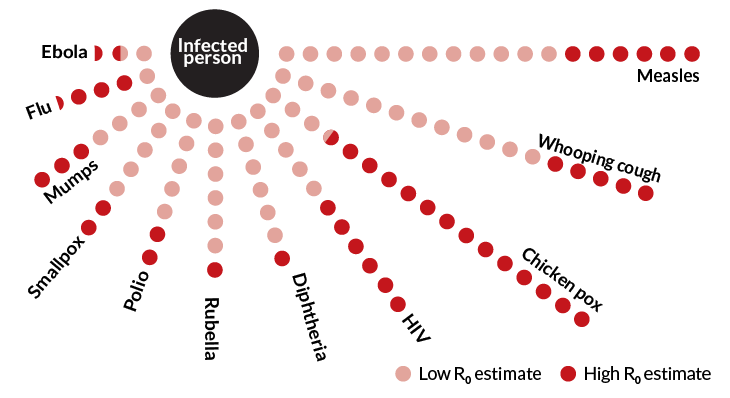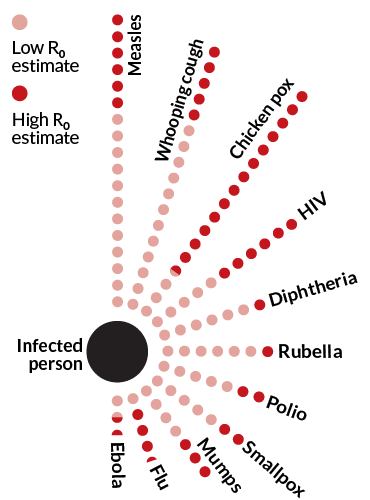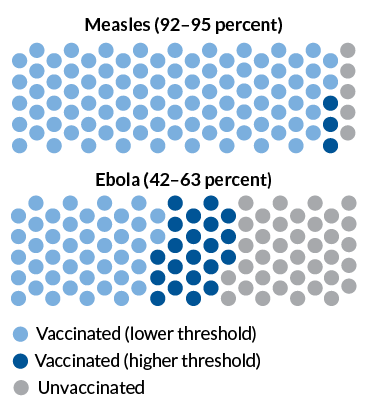One number can help explain why measles is so contagious
A disease’s R0 is the average number of people a person can infect in an unvaccinated population

GOING VIRAL Measles is extremely contagious. And one number, or rather a family of numbers, sums up the risk of its spread.
solidcolours/iStock/Getty Images Plus
- More than 2 years ago
Two ongoing outbreaks have dominated headlines in the past few months. Since the beginning of the year, measles has sickened at least 940 people in 26 U.S. states as of May 24. In Congo, Ebola has racked up 1,920 cases and killed 1,281 people since August 2018.
Those numbers are scary, but another number, or rather a range, illustrates the potential of these diseases to do damage. It’s called the basic reproduction number, or R0 (pronounced “R naught”), a ratio that describes the contagiousness or transmissibility of an infectious disease. If one person is infected in an unvaccinated population, R0 gives an estimate of how many people would get sick from that individual, on average. Researchers can use R0 to estimate things like the size of an outbreak, the infectiousness of an emerging disease or the effectiveness of tactics against a hypothetical bioterrorism threat.
Every infection event or outbreak has an R0. Three main variables go into calculating the ratio: how long people stay contagious (in days, for example), how often they come into contact with others on a daily basis and the probability of infecting someone else. Those factors are in turn influenced by things like the local environment, the average age of those infected, population density, public health resources and even the political climate. Within epidemics, R0 can vary from country to country and from one transmission route to another — for diseases that have more than one transmission route. That’s why when scientists talk about the R0 for a given disease more generally, they’re usually talking about a range.
Revealing ratio
The basic reproduction number, R0, of an infectious disease is the number of people on average that would catch the pathogen from one infected person in a population without any immunity against the disease. Each dot in this graphic represents a person who would catch the disease from an infected individual. R0 is usually expressed as a range because the factors that go into this ratio vary depending on the time and place of an outbreak.
Basic reproduction number (R0) range for selected infectious diseases


Source: P. Fine/Epidemiol. Rev. 1993; S. Hay et al/Philos. T. R. Soc. B 2013; G. Chowell and H. Nishiura/BMC Med. 2014
For measles, that range is 12 to 18, high compared with other infectious diseases. For Ebola, it’s generally 1.5 to 2.5. Given Ebola’s nightmarish symptoms and recent body count, that might be surprising. But R0 is a measure of contagiousness, not deadliness, and the transmission method is part of what matters. Measles is airborne whereas Ebola spreads through bodily fluids, so the odds of contact are lower.
“With measles, if you’re anywhere near someone with the disease, you could get it. It’s considered to be highly infectious,” if you’re not vaccinated against the disease, says David Smith, an epidemiologist at the University of Washington in Seattle.
R0 can also be used to determine the fraction of the population that needs to be vaccinated to prevent a disease from spreading, known as herd immunity. Textbooks boil the relationship down to a simple equation: 1-(1/R0). But for real outbreaks, the math gets a lot more complicated. “It’s a nasty computation,” Smith says.
For measles, generally 92 to 95 percent of a population needs to be vaccinated to reach herd immunity. Because Ebola has a lower R0 range, it also has a lower herd immunity threshold. Estimates suggest that 42 to 63 percent of the population needs to be vaccinated to establish herd immunity. However, because current vaccines are not 100 percent effective against Ebola’s various strains, some researchers argue that the threshold may actually be somewhat higher — and out of reach for ongoing vaccination efforts.
Why vaccines matter
R0 can also be used to determine the fraction of the population that needs to be vaccinated to prevent a particular disease from spreading, known as herd immunity. Because measles is so contagious, 92 to 95 percent of a population needs to be vaccinated (left). Below that threshold, pockets of the unvaccinated create holes in that herd immunity, helping the virus spread, as recent U.S. measles outbreaks have shown. For Ebola, the threshold is lower. Estimates suggest that roughly 42 to 63 percent of a population needs to be vaccinated to achieve herd immunity (right).
Herd immunity threshold range for measles and Ebola


Sources: R. Bednarczyk, W. Orenstein and S. Omer/Am. J. Epidemiol. 2016; K. Gittings and K.L. Matson/Vaccine 2016
While the R0 range might be able to tell you a lot about a disease or a case, it’s fallible. Researchers recently outlined R0’s faults in the January 2019 Emerging Infectious Diseases. Inconsistencies in its definition can result in misinterpretations among researchers and the public. And R0 can’t tell you how well a vaccine or another control method is working in an ongoing outbreak — for that you’d need to look at another reproduction number, R effective or Rt, which changes over the course of an outbreak.
“R0, as a descriptor of an epidemic, isn’t great,” Smith acknowledges, because it assumes pristine conditions. And in an epidemic, that’s rarely the case.
R0 has its limitations, but measles’ high number emphasizes why it’s good that there’s a vaccine for the potentially life-threatening disease. Before the vaccine was widely used starting in the 1960s, millions were infected each year, and hundreds died.
This story includes reporting by assistant deputy news editor Emily DeMarco.







